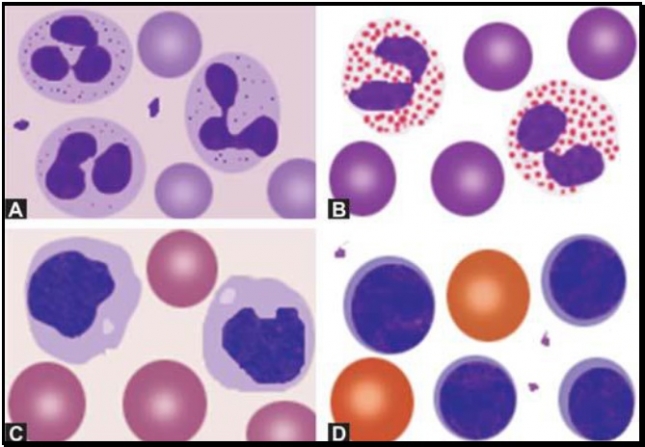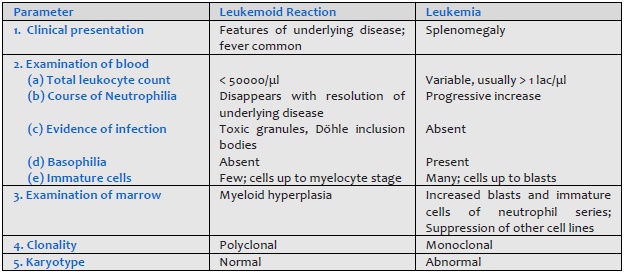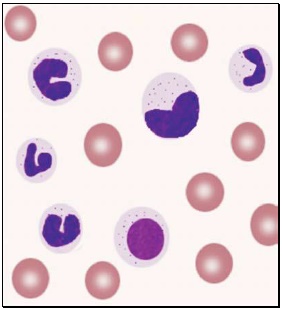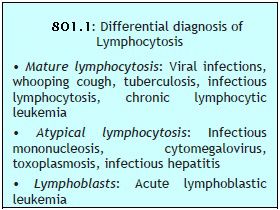Medically reviewed and approved by a board-certified member
Hemotology
NUMERICAL ABNORMALITIES OF LEUKOCYTES
By Dayyal Dg.Twitter Profile | Updated: Sunday, 06 August 2017 07:10 UTC

For meaningful interpretation, absolute count of leukocytes should be reported. These are obtained as follows:
Absolute Leukocyte Count = Leukocyte% × Total Leukocyte Count/ml
Neutrophilia:
An absolute neutrophil count greater than 7500/μl is termed as neutrophilia or neutrophilic leukocytosis.
Causes
- Acute bacterial infections: Abscess, pneumonia, meningitis, septicemia, acute rheumatic fever, urinary tract infection.
- Tissue necrosis: Burns, injury, myocardial infarction.
- Acute blood loss
- Acute hemorrhage
- Myeloproliferative disorders
- Metabolic disorders: Uremia, acidosis, gout
- Poisoning
- Malignant tumors
- Physiologic causes: Exercise, labor, pregnancy, emotional stress.
Leukemoid reaction: This refers to the presence of markedly increased total leukocyte count (>50,000/cmm) with immature cells in peripheral blood resembling leukaemia but occurring in non-leukemic disorders (see Figure 801.2). Its causes are:
- Severe bacterial infections, e.g. septicemia, pneumonia
- Severe hemorrhage
- Severe acute hemolysis
- Poisoning
- Burns
- Carcinoma metastatic to bone marrow Leukemoid reaction should be differentiated from chronic myeloid leukemia (Table 801.1).
Table 801.1 Differences between leukemoid reaction and leukemia


Figure 801.2 Leukemoid reaction in blood smear
Absolute neutrophil count less than 2000/μl is neutropenia. It is graded as mild (2000-1000/μl), moderate (1000-500/μl), and severe (< 500/μl).
Causes
I. Decreased or ineffective production in bone marrow:
- Infections
(a) Bacterial: typhoid, paratyphoid, miliary tuberculosis, septicemia
(b) Viral: influenza, measles, rubella, infectious mononucleosis, infective hepatitis.
(c) Protozoal: malaria, kala azar
(d) Overwhelming infection by any organism - Hematologic disorders: megaloblastic anemia, aplastic anemia, aleukemic leukemia, myelophthisis.
- Drugs:
(a) Idiosyncratic action: Analgesics, antibiotics, sulfonamides, phenothiazines, antithyroid drugs, anticonvulsants.
(b) Dose-related: Anticancer drugs - Ionizing radiation
- Congenital disorders: Kostman's syndrome, cyclic neutropenia, reticular dysgenesis.
II. Increased destruction in peripheral blood:
- Neonatal isoimmune neutropaenia
- Systemic lupus erythematosus
- Felty's syndrome
III. Increased sequestration in spleen:
- Hypersplenism
Eosinophilia:
This refers to absolute eosinophil count greater than 600/μl.
Causes
- Allergic diseases: Bronchial asthma, rhinitis, urticaria, drugs.
- Skin diseases: Eczema, pemphigus, dermatitis herpetiformis.
- Parasitic infection with tissue invasion: Filariasis, trichinosis, echinococcosis.
- Hematologic disorders: Chronic Myeloproliferative disorders, Hodgkin's disease, peripheral T cell lymphoma.
- Carcinoma with necrosis.
- Radiation therapy.
- Lung diseases: Loeffler's syndrome, tropical eosinophilia
- Hypereosinophilic syndrome.
Basophilia:
Increased numbers of basophils in blood (>100/μl) occurs in chronic myeloid leukemia, polycythemia vera, idiopathic myelofibrosis, basophilic leukemia, myxedema, and hypersensitivity to food or drugs.
Monocytosis:
This is an increase in the absolute monocyte count above 1000/μl.
Causes
- Infections: Tuberculosis, subacute bacterial endocarditis, malaria, kala azar.
- Recovery from neutropenia.
- Autoimmune disorders.
- Hematologic diseases: Myeloproliferative disorders, monocytic leukemia, Hodgkin's disease.
- Others: Chronic ulcerative colitis, Crohn's disease, sarcoidosis.
Lymphocytosis:
 This is an increase in absolute lymphocyte count above upper limit of normal for age (4000/μl in adults, >7200/μl in adolescents, >9000/μl in children and infants) (Box 801.1).
This is an increase in absolute lymphocyte count above upper limit of normal for age (4000/μl in adults, >7200/μl in adolescents, >9000/μl in children and infants) (Box 801.1).Causes
- Infections:
(a) Viral: Acute infectious lymphocytosis, infective hepatitis, cytomegalovirus, mumps, rubella, varicella
(b) Bacterial: Pertussis, tuberculosis
(c) Protozoal: Toxoplasmosis - Hematological disorders: Acute lymphoblastic leukemia, chronic lymphocytic leukemia, multiple myeloma, lymphoma.
- Other: Serum sickness, post-vaccination, drug reactions.
- Comment
- Posted by Dayyal Dg.
Tags:
End of the article